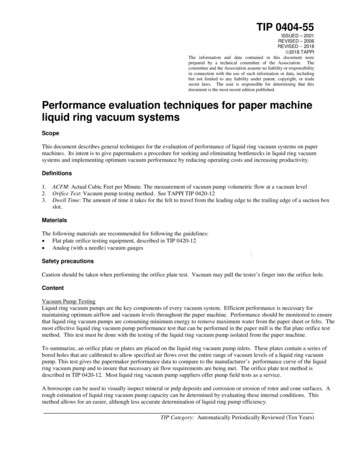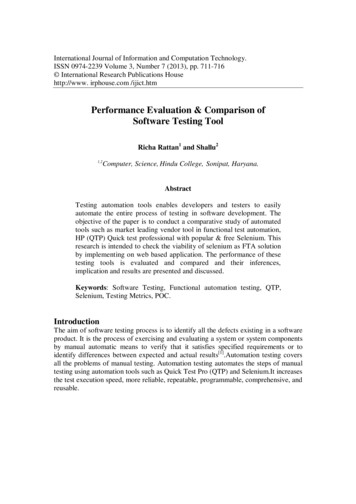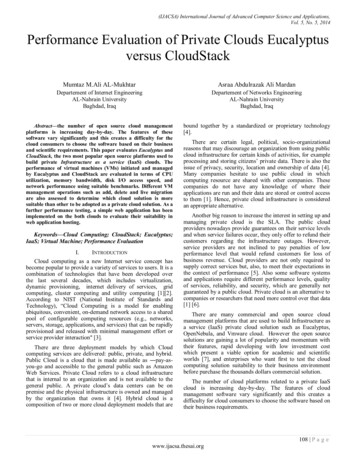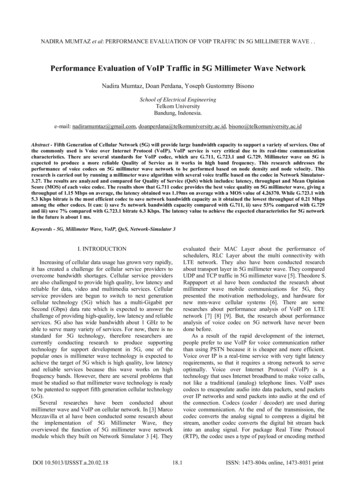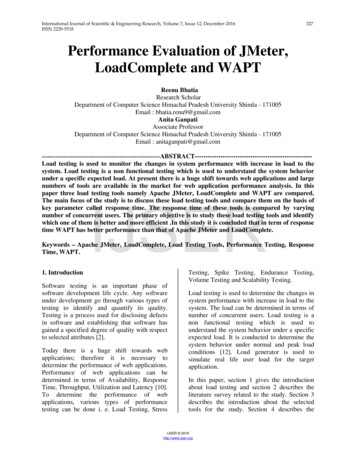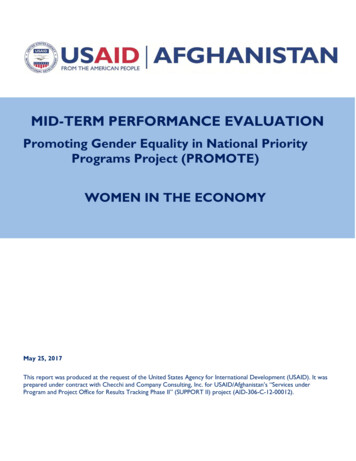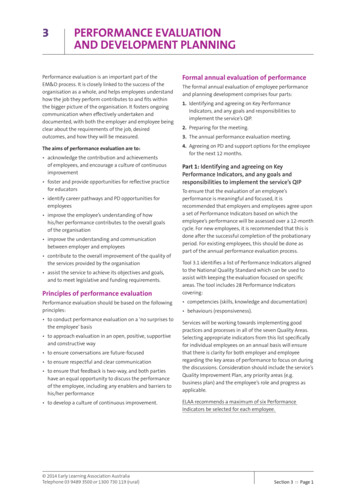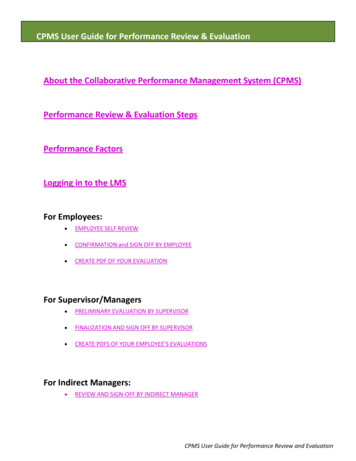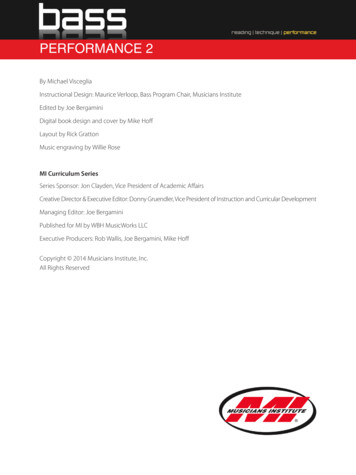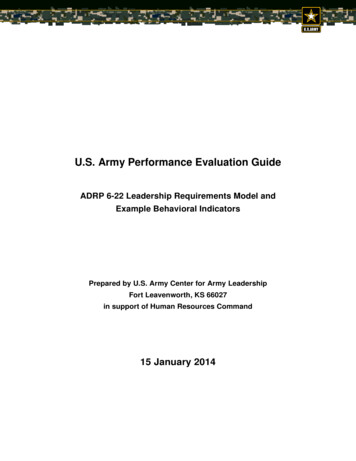
Transcription
U.S. Army Performance Evaluation GuideADRP 6-22 Leadership Requirements Model andExample Behavioral IndicatorsPrepared by U.S. Army Center for Army LeadershipFort Leavenworth, KS 66027in support of Human Resources CommandPage15 January 2014
How to use this Guide.This Guide is intended as a concise description of different levels of Army leadership competenciesand attributes. Pages 2 and 3 present the Army Leadership Requirements Model from leadershipdoctrine (ADP 6-22 and ADRP 6-22) and a short description of the three categories of leadershipcompetencies and three categories of leader attributes.Page 3 of this Guide also provides short pointers about how a rater prepares to observe asubordinate leader’s performance.Pages 4 through 14 provide examples of what each of the ten leadership competencies look likeand what each of the thirteen attributes look like. For each of the ten and thirteen an example isgiven of what performance looks like in the categories of developmental need, standard andstrength. The three categories are ordered in terms of what can be expected from novice toseasoned performer to expert. These examples are NOT to be used as excerpts for formalperformance appraisals and only serve as a guide in differentiating the level of performance.Pages 15 through 22 reproduce the detailed tables from ADRP 6-22 that show example behaviorsrelated to leadership competencies and attributes. These behaviors are what a leader is expectedto do or to demonstrate. In comparison, the descriptions of developmental need, standard, andstrength on pages 4-14 are how well a leader performs in relation to these expectations. The ADRP6-22 tables provide expanded information on doctrinal requirements than what is contained on DAForm 67-10-1, Part IV.Page 23 of this Guide provides a brief summary of what result the ten leadership competenciesshould have. It also shows how performance can vary along four levels of performance. The fourcategories differentiating performance are based on a combination of: a) the extent ofdemonstration of a desired behavior, b) the ability and initiative shown in learning to improve orengage in a desired behavior, and c) the extent and duration of impact that the behavior has onself, others or unit performance.The examples of the level of competencies and attributes were drawn from a related publication(Developing Leadership During Unit Training Exercises) that was produced to be an observationguide for trainers, mentors, observer/controllers. Refer to that guide and other leadership products(see CAL webpage http://usacac.army.mil/cac2/CAL/) to learn more about the processes of creatinga climate for development, observing leadership, delivering feedback for impact, guiding learningand development, and taking steps to improve leadership.1
Army Leadership Requirements ModelUnderstanding the competencies and attributes in the Army Leadership Requirements Model isessential to make careful and accurate observations of a subordinate’s performance and potential.The core leader competencies include how Army leaders lead people; develop themselves, theirsubordinates, and organizations; and achieve the mission. The competencies are the most outwardlyvisible signs of a leader’s performance.Leader attributes are inward characteristics of the individual that shape the motivations for actions andbearing, and how thinking affects decisions and interactions with others.Core Leader Competency Categories Lead – Leaders set goals and establish a vision, motivate or influence others to pursue the goals,build trust to improve relationships, communicate and come to a shared understanding, serveas a role model by displaying character, confidence, and competence, and influence outside thechain of command. Develop – Leaders foster teamwork; express care for individuals; promote learning; maintainexpertise, skills and self-awareness; coach, counsel and mentor others; foster job development,and steward the profession of Arms. Achieve – Leaders set priorities, organize taskings, manage resources, execute plans toaccomplish the mission, and achieve goals.2
Attribute Categories Displays Character – Factors internal and central to a leader, which make up an individual’s coreand are the mindset and moral foundation behind actions and decisions. Leaders of characteradhere to Army Values, display empathy and the Warrior Ethos, and practice good discipline. Displays Presence – How a leader is perceived by others based on the leader’s appearance,demeanor, actions and words. Leaders with presence demonstrate military and professionalbearing, fitness, confidence and resilience. Displays Intellectual Capacity – Mental tendencies or resources that shape a leader’sconceptual abilities and affect a leader’s duties and responsibilities. Leaders with high intellectare mentally agile, good at judgment, innovative, tactful around others, and expert in technical,tactical, cultural, geopolitical, and other relevant knowledge areas.Accurate, Descriptive ObservationsObserving leadership is accomplished by watching how a leader interacts with others and influencesthem. Written directives, verbal communications, and leader actions all provide indications of how aleader performs. Raters also learn about their subordinates’ leadership by observing for reactions to thesubordinate among peers, subordinates, and other superiors.When observing leadership, the following three key components ensure observations are accurate anddescriptive:1. Plan ahead to take multiple observations during the rating period. Use both keyevents and routine operations.2. Make observations based on the leadership requirements model (ADRP 6-22) and theindividual’s duty descriptions and performance objectives. Look for a pattern ofbehavior. Seek to confirm initial impressions. Be alert for changes in performance andcauses for strengths, inconsistencies, or weaknesses.3. Record important observations immediately for later use in performance andprofessional growth counseling and for the OER.3
What Leads Looks LikeCore Leader Competencies: LeadsLeads OthersBuilds TrustCommunicatesExtends Influence beyond the Chain of CommandLeads by ExampleLEADS OTHERS Developmental NeedInconsistently demonstrates influence techniques. Fails to carefully monitor risk factors affectingothers. Allows mission priority to adversely affect subordinate morale, physical condition, or safety.Hesitates to act when risk factors escalate. StandardInfluences others effectively. Assesses and routinely monitors the impact of task execution onsubordinate welfare. Monitors conditions of subordinate morale and safety. Implementsappropriate interventions when conditions jeopardize mission success. Assesses and manages risk. StrengthDemonstrates full range of influence techniques. Continually assesses and monitors missionaccomplishment and Soldier welfare. Attends to subordinate morale, physical condition, and safety.Implements interventions to improve situations. Exudes a safety-conscious attitude.BUILDS TRUST Developmental NeedInconsistently demonstrates trust. Displays respect differently to some without justification. Takesno actions to build rapport or trust with others. Fails to address problems caused by team memberswho undermine trust in the unit. Fails to follow through on intentions, undermining the trust otherswould have in this leader. StandardEstablishes trust by demonstrating respect to others and treating others in a fair manner. Usescommon experiences to relate to others and build positive rapport. Engages others in activities andsharing of information that contribute to trust. StrengthDemonstrates trust in others when encountering new or unfamiliar situations. Bases trust on athorough understanding of trustworthiness of others and self. Understands how much trust toproject and to grant to others. No hesitation in addressing problems that undermine trust.EXTENDS INFLUENCE BEYOND THE CHAIN OF COMMAND Developmental NeedInconsistently demonstrates understanding of indirect influence. Misses or passively acts onopportunities to build trusting relationships outside the organization. StandardDemonstrates understanding of conditions of indirect influence. Builds trust to extend influenceoutside the organization. Displays understanding of the importance of building alliances.4
StrengthDemonstrates effective use of indirect influence techniques. Establishes trust to extend influenceoutside the chain of command. Proactively builds and maintains alliances to benefit theorganization.LEADS BY EXAMPLE Developmental NeedDemonstrates behavior inconsistent with the Army Values. Displays a lack of commitment andaction. Remains unaware of or unconcerned about the example being set. StandardDemonstrates an understanding of leader attributes and competencies. Recognizes the influence ofpersonal behavior and the example being set. Displays confidence and commitment when leadingothers. StrengthModels sound leader attributes and competencies. Exemplifies the Warrior Ethos through actionsregardless of situation. Demonstrates competence, confidence, commitment, and an expectation ofsuch behavior in others.COMMUNICATES Developmental NeedMisunderstands or fails to perceive nonverbal cues. Ideas not well organized or easilyunderstandable. Speaks without considering listener interest. Information dissemination isinconsistent or untimely. StandardChooses appropriate information-sharing strategy before communicating. Conveys thoughts andideas appropriately. Disseminates information in a timely manner. Provides guidance and asks for abrief back or confirmation. StrengthUses verbal and nonverbal means to maintain listener interest. Adjusts information- sharing strategybased on operating conditions. Ensures information dissemination to all levels in a timely manner.Avoids miscommunication through verifying a shared understanding.5
What Develops Looks LikeCore Leader Competencies: DevelopsCreates a Positive Environment/Fosters Esprit de CorpsPrepares SelfDevelops LeadersStewards the ProfessionCREATES A POSITIVE ENVIRONMENT/FOSTERS ESPRIT DE CORPS Developmental NeedDemonstrates negative expectations and attitudes not conducive to a productive work environment.Focuses primarily on task accomplishment. Fosters an expectation of zero-defects. Holds honestmistakes against subordinates. StandardPromotes expectations and attitudes conducive to a positive work environment. Demonstratesoptimism and encourages others to develop and achieve. Provides coaching, counseling andmentoring to others. StrengthExemplifies a positive attitude and expectations for a productive work environment. Conveys apriority for development within the organization. Encourages innovative, critical, and creativethought. Leverages lessons learned to improve organization.PREPARES SELF Developmental NeedReluctant to accept responsibility for learning. Downplays feedback from others. Acts oninformation without regard to source, quality, or relevance. Ineffectively transfers new informationinto knowledge. StandardAccepts responsibility for learning and development. Evaluates and incorporates feedback fromothers. Analyzes and organizes information to create knowledge. Focuses on credible sources ofinformation to improve personal understanding. StrengthSeeks feedback from others. Seeks learning opportunities to improve self. Demonstrates knowledgemanagement proficiency. Integrates information from multiple sources; analyzes, prioritizes, andutilizes new information to improve processes.DEVELOPS LEADERS Developmental NeedDisinterested in motivating and assisting in the growth of others. Focuses on the task at handwithout consideration of improving organizational effectiveness. StandardDemonstrates willingness to motivate and help others grow. Provides coaching, counseling andmentoring. Builds team skills and processes to improve individuals and the organization.6
StrengthSeizes opportunities to teach, coach and mentor. Fosters job development and enrichment. Knowssubordinates and prepares them for new positions. Improves unit productivity.STEWARDS THE PROFESSION Developmental NeedFails to extend assistance to others or other units. Disregards oversight of the tracking and use ofresources. Fails to improve subordinates for follow-on assignments and fails to take steps to leavethe organization in equal or better condition than when this leader arrived. StandardSupports developmental opportunities of subordinates. Takes steps to improve the organization.Carefully manages resources of time, equipment, people, and money. StrengthApplies a mindset that looks to strengthen the profession of arms into the future. Assumes somerisk to forego some short-term or personal gains in favor of improving one’s own organization, otherunits, and other individuals. Cooperates by providing more assistance to others than expected toreceive in return.7
What Achieves Looks LikeCore Leader Competencies: AchievesGets ResultsGETS RESULTS Developmental NeedDemonstrates a limited understanding of supervising, managing, monitoring, and controllingpriorities of work. Hasty prioritization and planning lead to incomplete guidance and direction. StandardPrioritizes, organizes, and coordinates taskings for others. Plans for expected setbacks and enactsappropriate contingencies when needed. Monitors, coordinates and regulates subordinate actionsbut allows subordinates to accomplish the work. StrengthUtilizes other competencies to accomplish objectives. Demonstrates understanding of supervising,managing, monitoring, and controlling of priorities of work. Reflects on end state prior to issuingguidance. Provides subordinates autonomy to accomplish the work.8
What Character Looks LikeA Leader of Character Demonstrates:Army ValuesEmpathyWarrior Ethos/Service EthosDisciplineARMY VALUES Developmental NeedInconsistently demonstrates: Loyalty, Duty, Respect, Selfless Service, Honor, Integrity, and PersonalCourage. Demonstrates these with more than occasional lapses in judgment. StandardConsistently demonstrates: Loyalty, Duty, Respect, Selfless Service, Honor, Integrity, and PersonalCourage. StrengthModels Loyalty, Duty, Respect, Selfless Service, Honor, Integrity, and Personal Courage. Promotesthe associated principles, standards, and qualities in others.EMPATHY Developmental NeedExhibits resistance or limited perspective on the needs of others. Words and actions communicatelack of understanding or indifference. Unapproachable and disinterested in personally caring forSoldiers. StandardDemonstrates an understanding of another person’s point of view. Identifies with others’ feelingsand emotions. Displays a desire to care for Soldiers and others. StrengthAttentive to other’s views and concerns. Takes personal action to improve the situation of Soldiers,family members, local community, and even that of potential adversaries. Breaks into training,coaching, or counseling mode when needed and role models empathy for others.WARRIOR ETHOS/SERVICE ETHOS Developmental NeedInconsistently demonstrates the spirit of the profession of arms. Downplays the importance of thissentiment. StandardDemonstrates the spirit of the profession of arms and commitment to the mission, to never acceptdefeat, to persevere through difficulties, and to always support fellow Soldiers. StrengthModels the spirit of the profession of arms. Instills this behavior in subordinates and others.DISCIPLINE Development NeedFails to consistently adhere to rules, regulations, or standard operating procedures.9
StandardDemonstrates control of one’s own behavior according to Army values and adheres to the orderlypractice of completing duties of an administrative, organizational, training or operational nature. StrengthDemonstrates discipline in one’s own performance and encourages others to follow good practicesof discipline as well. As situations call for it, readily enforces discipline when others fail to adhere toArmy Values or to other standard practices.10
What Presence Looks LikeA Leader with Presence Demonstrates:Military and Professional BearingFitnessConfidenceResilienceMILITARY AND PROFESSIONAL BEARING Developmental NeedInconsistently projects a professional image of authority. Actions lack a commanding presence.Allows professional standards to lapse in personal appearance, demeanor, actions, and words. StandardPossesses a commanding presence. Projects a professional image of authority. Demonstratesadherence to standards. StrengthModels a professional image of authority. Commanding presence energizes others. Exemplifiesadherence to standards through appearance, demeanor, actions, and words.FITNESS Developmental NeedPhysical health, strength, or endurance is not sufficient to complete most assigned missions. Fitnesslevel unable to support emotional health and conceptual abilities under prolonged stress. StandardDisplays sound health, strength, and endurance that support emotional health and conceptualabilities under prolonged stress. StrengthModels physical health and fitness. Strength and endurance supports emotional health andconceptual abilities under prolonged stress. Energetic attitude conveys importance of fitness toothers.CONFIDENCE Developmental NeedInconsistently displays composure or a calm presence. Allows a setback to derail motivation.Displays a less than professional image of self or unit. StandardDisplays composure, confidence, and mission-focus under stress. Effectively manages own emotionsand remains in control of own emotions when situations become adverse. StrengthProjects self-confidence and inspires confidence in others. Models composure, an outward calm,and control over emotions in adverse situations. Manages personal stress, and remains supportiveof stress in others.11
RESILIENCE Developmental NeedSlowly recovers from adversity or stress. Inconsistently maintains a mission or organizational focusafter a setback. StandardRecovers from setbacks, shock, injuries, adversity, and stress while maintaining a mission andorganizational focus. StrengthQuickly recovers from setbacks. Focuses on the mission and objectives in the midst of shock,injuries, and stress. Maintains organizational focus despite adversity. Learns from adverse situationsand grows in resilience.12
What Intellectual Capacity Looks LikeA Leader with Intellectual Capacity Demonstrates:Mental AgilitySound JudgmentInnovationInterpersonal TactExpertiseMENTAL AGILITY Developmental NeedInconsistently adapts to changing situations. Attends to immediate conditions and surface outcomeswhen making decisions. Hesitates to adjust an approach. StandardDemonstrates open-mindedness. Recognizes changing conditions and considers second- and thirdorder effects when making decisions. StrengthModels a flexible mindset and anticipates changing conditions. Engages in multiple approacheswhen assessing, conceptualizing, and evaluating a course of action.SOUND JUDGMENT Developmental NeedInconsistently demonstrates sound assessment of situations. Hesitates in decisiomaking when factsnot available. Forms opinions outside of sensible information available. StandardDemonstrates sound decisionmaking ability. Shows consideration for available information, evenwhen incomplete. StrengthModels sound judgment. Engages in thoughtful assessment. Confidently makes decisions in theabsence of all of the facts.INNOVATION Developmental NeedRelies on traditional methods when faced with challenging circumstances. Hesitates to introducenew or novel ideas when given the opportunity or when appropriate. StandardOffers new ideas when given the opportunity. Provides novel recommendations when appropriate. StrengthConsistently introduces new ideas when opportunities exist. Creatively approaches challengingcircumstances and produces worthwhile recommendations.INTERPERSONAL TACT Developmental NeedDe
This Guide is intended as a concise description of different levels of Army leadership competencies and attributes. Pages 2 and 3 present the Army Leadership Requirements Model from leadership doctrine (ADP 6-22 and ADRP 6-22) and a short description of the three categories of leadership compete


